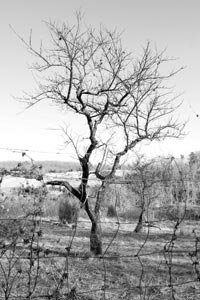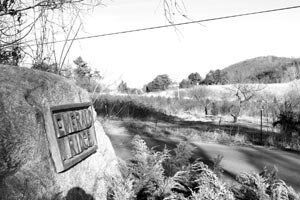>> Back to The HooK front page
NEWS- Orchard fall-out: Fears of arsenic and old lead surface
Published February 10, 2005, in issue 0406 of The Hook
BY LISA PROVENCE
Crozet once led the state in the production of Albemarle pippins and winesap apples, and in the 1930s, it was known as the "peach capital" of Virginia. However, decades of pesticide spraying in those orchards have left another legacy: lead and arsenic in the soil.
While the Environmental Protection Agency is downplaying the threat of contamination, some tests have already revealed elevated concentrations of these heavy metals on land that once grew trees but now grows subdivisions.
"The data is not releasable to the public because it's private, residential property," says Chris Wagner with the EPA. "If we find contamination, we'll go to the neighboring properties."
Wagner does confirm that some land in Emerald Ridge and one adjacent property above Mint Springs Park were found to have elevated levels of arsenic and lead during EPA tests in 2002 which also included the Grayrock and Wayland's Grant subdivisions.
When The Hook spoke to Wagner in early January, she didn't rule out the possibility of either soil remediation or stabilization through additional plantings in some "isolated areas." Since then, Wagner has not returned repeated phone calls seeking information on the test results.
Some Crozet residents say they were led to believe everything was fine following the 2002 tests.
"The EPA is giving people a false sense of security," says Tom Loach, who lives in sight of Grayrock. "Everything in Crozet was orchards. Everything out there has the potential to be contaminated."
EPA coordinator Linda Baxter did the original sampling in 2002. "If you have years of applying pesticides, there are going to be contaminants," she says. She determined that some of the elevated levels warranted further investigation.
The Virginia Department of Environmental Quality also did some testing.
"Just because there are elevated levels doesn't mean it's dangerous or that you're going to get sick," says Pat McMurray, a DEQ scientist. "We don't want people to get panicky if they have elevated levels."
Arsenic is a carcinogen that can occur naturally in soil at levels of 10 to 12 parts per million, according to McMurray. The EPA uses 6 to 7 parts per million as the screening level, which means the risk of cancer is about one in a million, she explains, adding, "That's a fairly low risk." Levels of 200 and 261ppm were found at some sites in Crozet.
While such levels may not constitute an emergency, the EPA recommends that residential concentrations not exceed 20ppm. Remediation in Superfund sites typically begins at 200ppm. "When you get in the 1-in-10,000 risk level [for cancer], we want to make sure people aren't exposed," says McMurray.
Lead contamination is always a concern for small children, and the screening level for that is 400ppm. The highest number found in Crozet was 1780ppm, but that doesn't necessarily mean the soil is dangerous.
"It's higher than you want to see in a residential area," says McMurray. "If you're over that screening level, we'd want to look at educating people."
Basically that means washing hands-- particularly for children who play outside and are most susceptible to hand-to-mouth contamination-- and keeping grass planted in the yard.
Even at elevated levels, risk assessment assumes exposure 350 days a year for 30 years. Kids would have to be scarfing down 200 milligrams of soil a day-- about an eighth of a teaspoon-- and even then they'd still be at the 1-in-10,000 probability for cancer, says McMurray.
The lead arsenate that was sprayed on fruit trees tends to stay close to the surface and is not prone to leach into the soil, says McMurray.
Loach believes the EPA's surface testing method was not the correct methodology and that core samples should have been done instead-- a contention the EPA disputes.
"Why would we be interested in the core?" asks the EPA's Linda Baxter. "The immediate threat would be on the surface."
Loach also is concerned that digging-- particularly major earth-moving in new subdivisions such as Old Trail beside Henley Middle School-- poses inhalation threats. But there's no requirement to have soil testing done at old orchard sites.
He also contends that Albemarle County has long been aware of elevated arsenic and lead levels in its designated growth area.
"If there were sites where we might have concerns," says county spokeswoman Lee Catlin, "our responsibility is to notify the EPA and DEQ. Virginia law does not give us any authority to regulate or step in ahead of the DEQ and EPA." She says the EPA is aware of the county's concerns about possible contamination at construction sites such as Old Trail.
Catlin also points out that the information the EPA has on the testing it's now doing is considered exempt from the Freedom of Information Act-- unlike Superfund sites such as one in Greenwood.
"You certainly don't want to be accused of burying information if there's a danger," says David Wayland, president of the Crozet Community Association, which has formed a committee to investigate the EPA investigation.
Wayland, whose family orchard became the Emerald Ridge subdivision, still lives nearby. He doesn't believe there's widespread contamination. He thinks the elevated levels are coming from where the lead arsenate and other pesticides were mixed or were spilled.
"I know places where chemicals were mixed," he says. "I wouldn't grow vegetables or drink water from there."
The EPA collected groundwater samples from 10 residential wells in 2002, but did not find elevated levels of lead, arsenic, or pesticides in those wells, according its Emerging Sites report on Crozet subdivisions.
With Crozet a designated growth area, and myriad developments springing up, there's some fear that the discovery of elevated levels of lead and arsenic will affect housing prices.
"I know developers are concerned and talking about this," says Wayland. "It's a problem. Developers don't want to scare people. It's an unseen threat. You don't want it to affect property values."
While his land came up clean when the EPA tested it, Loach plans to have it tested again, and he worries that he'll have to disclose that if he sells his house. "It's a financial question, and it's a moral and ethical decision," he says.
Overall, the threat from lead arsenate seems minor compared to the major cleanup that will have to take place at the old Acme Visible Records plant, where residue from painting file cabinets has seeped into the groundwater.
"I remember my father came in out of the orchard soaked to the skin" with lead arsenate," says Wayland. His father also sprayed Malathion and DDT. "He lived to 88. His father to 92. I'm not saying it's not a danger. Maybe he'd lived to be 100 if he hadn't sprayed it," Wayland says.
Wayland doesn't think people should be frightened of the lead and arsenic levels, but "They should be aware there are hot spots in the Crozet area," he says.
"It will never be a Superfund site," says the EPA's Linda Baxter of the lead and arsenic threat to Crozet. "It's not significant enough."


Some properties at Emerald Ridge subdivision, a former orchard, have been tested for elevated levels of lead and arsenic, but the EPA won't say how many or how serious the test results are.
PHOTO BY LINCOLN ROSS BARBOUR
#
>> Back to The HooK front page
|